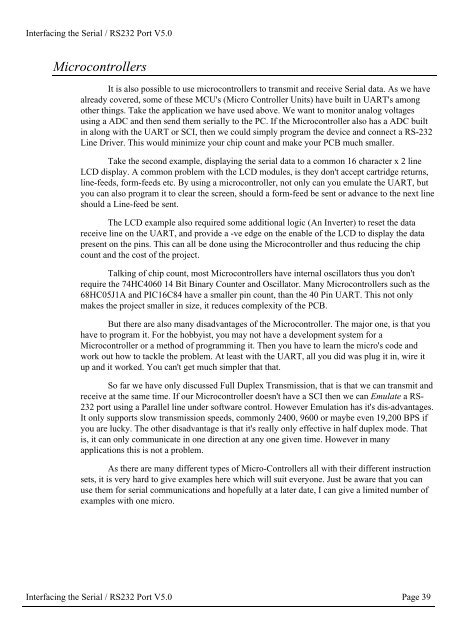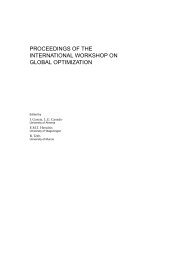Interfacing the Serial/RS-232 Port
Interfacing the Serial/RS-232 Port
Interfacing the Serial/RS-232 Port
Create successful ePaper yourself
Turn your PDF publications into a flip-book with our unique Google optimized e-Paper software.
<strong>Interfacing</strong> <strong>the</strong> <strong>Serial</strong> / <strong>RS</strong><strong>232</strong> <strong>Port</strong> V5.0<br />
Microcontrollers<br />
It is also possible to use microcontrollers to transmit and receive <strong>Serial</strong> data. As we have<br />
already covered, some of <strong>the</strong>se MCU's (Micro Controller Units) have built in UART's among<br />
o<strong>the</strong>r things. Take <strong>the</strong> application we have used above. We want to monitor analog voltages<br />
using a ADC and <strong>the</strong>n send <strong>the</strong>m serially to <strong>the</strong> PC. If <strong>the</strong> Microcontroller also has a ADC built<br />
in along with <strong>the</strong> UART or SCI, <strong>the</strong>n we could simply program <strong>the</strong> device and connect a <strong>RS</strong>-<strong>232</strong><br />
Line Driver. This would minimize your chip count and make your PCB much smaller.<br />
Take <strong>the</strong> second example, displaying <strong>the</strong> serial data to a common 16 character x 2 line<br />
LCD display. A common problem with <strong>the</strong> LCD modules, is <strong>the</strong>y don't accept cartridge returns,<br />
line-feeds, form-feeds etc. By using a microcontroller, not only can you emulate <strong>the</strong> UART, but<br />
you can also program it to clear <strong>the</strong> screen, should a form-feed be sent or advance to <strong>the</strong> next line<br />
should a Line-feed be sent.<br />
The LCD example also required some additional logic (An Inverter) to reset <strong>the</strong> data<br />
receive line on <strong>the</strong> UART, and provide a -ve edge on <strong>the</strong> enable of <strong>the</strong> LCD to display <strong>the</strong> data<br />
present on <strong>the</strong> pins. This can all be done using <strong>the</strong> Microcontroller and thus reducing <strong>the</strong> chip<br />
count and <strong>the</strong> cost of <strong>the</strong> project.<br />
Talking of chip count, most Microcontrollers have internal oscillators thus you don't<br />
require <strong>the</strong> 74HC4060 14 Bit Binary Counter and Oscillator. Many Microcontrollers such as <strong>the</strong><br />
68HC05J1A and PIC16C84 have a smaller pin count, than <strong>the</strong> 40 Pin UART. This not only<br />
makes <strong>the</strong> project smaller in size, it reduces complexity of <strong>the</strong> PCB.<br />
But <strong>the</strong>re are also many disadvantages of <strong>the</strong> Microcontroller. The major one, is that you<br />
have to program it. For <strong>the</strong> hobbyist, you may not have a development system for a<br />
Microcontroller or a method of programming it. Then you have to learn <strong>the</strong> micro's code and<br />
work out how to tackle <strong>the</strong> problem. At least with <strong>the</strong> UART, all you did was plug it in, wire it<br />
up and it worked. You can't get much simpler that that.<br />
So far we have only discussed Full Duplex Transmission, that is that we can transmit and<br />
receive at <strong>the</strong> same time. If our Microcontroller doesn't have a SCI <strong>the</strong>n we can Emulate a <strong>RS</strong>-<br />
<strong>232</strong> port using a Parallel line under software control. However Emulation has it's dis-advantages.<br />
It only supports slow transmission speeds, commonly 2400, 9600 or maybe even 19,200 BPS if<br />
you are lucky. The o<strong>the</strong>r disadvantage is that it's really only effective in half duplex mode. That<br />
is, it can only communicate in one direction at any one given time. However in many<br />
applications this is not a problem.<br />
As <strong>the</strong>re are many different types of Micro-Controllers all with <strong>the</strong>ir different instruction<br />
sets, it is very hard to give examples here which will suit everyone. Just be aware that you can<br />
use <strong>the</strong>m for serial communications and hopefully at a later date, I can give a limited number of<br />
examples with one micro.<br />
<strong>Interfacing</strong> <strong>the</strong> <strong>Serial</strong> / <strong>RS</strong><strong>232</strong> <strong>Port</strong> V5.0 Page 39
















